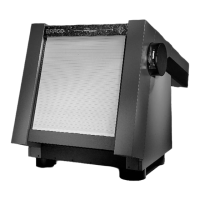Field Service Manual December 2003
Page 181 of 276
Theory of the optics
Description of the laser path
See also drawing 39251
The laser, L1, L2, M1
The laser 05LHP151 produces a linearly polarized laser beam (laser
tube is rotated so that the polarization is in the S-plane) and passes
through L1(F50) and L2(-F40). These lenses are spherical lenses and
deform the spot in both directions.
The beam is reflected by mirror M1 and then the laser beam enters the
beam splitter with the correct angle.
Beam splitter
The beam splitter consists of a mirror and a splitting prism. The splitter
prism is coated on 6 different regions with coatings that have different
transmissions. 16% of the laser beam emerges from the bottom coated
region and 84% is deviated towards the mirror. This beam is reflected
100% by the mirror and emerges from the second coated region on the
prism. Again a part of the beam is deviated and is reflected by the mirror.
This is repeated until six beams emerge from splitter. The mirror is
placed with regard to the splitter prism in such a way that the 6 beams
converge in 1 point: the Telecentric Point. The optical path length of the
six beams leaving the mirror is different. Hence, the sharpest spot for
each of the beams will be located on a different position. To have the
same spot performance for all of the 6 beams, the lenses are needed
before the splitter to make a thick spot. The splitter deforms the spot in
the X- and Y-directions in a different way and this is also compensated
by the different lenses in the path.

